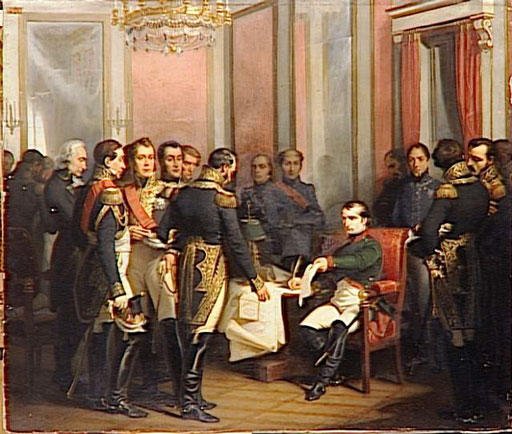
Royal Family chased out of Portugal
As fascinating as it may seem, there are potential links that may well prove to facilitate a connection to the Royal Family of Portugal. Not necessarily directly, but it’s intriguing to think that our ancestors may have been instrumental in securing the safety of it’s Monarchy. I’ve included the information as part of my research to give you a perspective on how global the Portuguese nation was at certain times in history and to peak your interest in the ‘de Barros’ lineage.
1807 AD – Portugal finds herself without any alternatives as her land frontier has been invaded by France and Spain; the march towards Lisbon was now in full progress. France and Spain had, on October 27, signed the Treaty of Fontainebleau; Portugal should be divided into three parts and handed over to her captors. The last straw came with the report, in the Le Moniteur of 11th of November, in which Bonaparte in an interview made it clear what would happen to the royal family of Portugal when his troops arrived there.
The State Council, presided by the Prince Regent took the decision to leave for Brazil. Dom João’s intelligence is apparent as all the ships of his navy were ready to sail. During the previous six months the voyage had been planned, without raising suspicion in France or Spain. Another trump card was the Agreement signed on the 22nd of October. The nation that dominated the seas would escort the Portuguese fleet on her voyage.
On the 27th of that month the royal family embarked. They were distributed as follows: on the ship-of-the-line Príncipe Real – Queen D. Maria I, Prince Regent D. João, Prince of Beira infante D. Pedro, his brother infante D. Miguel and the infante of Spain D. Pedro Carlos; on the Afonso de Albuquerque – Princess of Brazil D. Carlota Joaquina, with her daughters, infantas D. Maria Isabel Francisca, D. Maria d’ Assunção, D. Ana de Jesus and Princess of Beira infanta D. Maria Tereza; on the Príncipe de Brasil – the widow Princess D. Maria Francisca Benedita and the infanta D. Maria Ana, both sisters to the Queen; and, on board the Rainha de Portugal – the daughters of D. Carlota Joaquina, infantas D. Maria Francisca de Assis and D. Isabel Maria.
1808 AD – José Vitorino de Barros and Maria Isabel de Barros of the Portuguese Royal family moved to Brazil, then the largest and wealthiest colony of Portugal. Two years later, on 10 July 1810, José de Barros arrived in the Brazilian capital, Rio de Janeiro. As a crew member of the frigate D. Carlota, he was charged with transporting what remained of the personal property of Prince Regent Dom João, later King Dom João VI to Brazil. José de Barros also brought his family on the voyage, including Joaquim Inácio, who was then one year and eight months old. Joaquim Inácio had an older sister named Maria and six younger siblings (who were born after the arrival in Brazil), among them Bento José de Carvalho and Antônio José Vitorino de Barros.

Joaquim José Inácio, Viscount of Inhaúma (1 August 1808 – 8 March 1869) was a naval officer, politician and monarchist of the Empire of Brazil. After Brazilian independence in 1822, Inhaúma enlisted in the armada (navy) of Brazil. Early in his career during the latter half of the 1820s, he participated in the subduing of secessionist rebellions: first the Confederation of the Equator, and then the Cisplatine War, which precipitated a long international armed conflict with the United Provinces of the Río de la Plata.
Throughout the chaos that characterized the years when Emperor Dom Pedro II was a minor, Inhaúma remained loyal to the government. He helped quell a military mutiny in 1831 and was involved in suppressing some of the other rebellions that erupted during that troubled period. He saw action in the Sabinada between 1837 and 1838, followed by the War of the Ragamuffins from 1840 until 1844. In 1849, after spending two years in Great Britain, Inhaúma was given command of the fleet that was instrumental in subduing the Praieira revolt, the last rebellion in imperial Brazil
Antônio José Vitorino de Barros Accounts of the movements of this younger brother are sadly dismal. Likewise are another of the siblings that appears sporadically on some lineages with the name Antonio Pereira, with no mention of the ‘de Barros‘ extension. It is possible that they separated from the family’s estate to further their opportunities abroad dissappearing from the family’s royal line.
I’ve considered that he could be a part of our family heritage because of the associations which have had me perched on the edge of my seat, and searching enthusiastically for more. Quite the bridge to jump across I’m ready to admit, but given my Great Great Great Grandfathers level of education and knowledge of the seas and navigation, it’s not that big a jump to consider either of the above Antonio’s may have reappeared in the historic record as a trader in the Pacific Islands emerging from Rio de Janeiro, Brazil.